The Neoprene Suit: Essential Gear for Cold Weather Kiteboarding
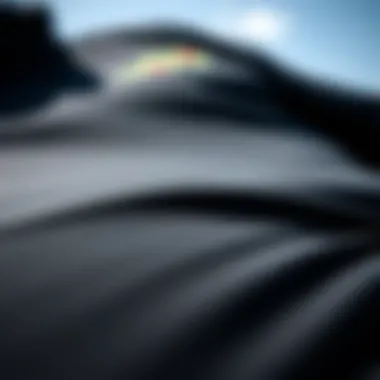

Intro
Kiteboarding in cold weather can feel like an exhilarating rollercoaster, but there's no denying the chill can be a hard pill to swallow. Enter the neoprene suit—a veritable shield against the cold, allowing you to cut through biting winds and frigid waters with flair. These suits aren't just cozy; they are crafted from high-tech materials that ensure both warmth and flexibility, allowing riders to perform their best even when temperatures drop. So, whether you’re a novice looking to dip your toes into the icy waters or a seasoned pro aiming to conquer the elements, understanding the ins and outs of neoprene suits is essential.
In the following sections, we’ll unpack the vital gear for kiteboarding in cold climates, delve into the nuances of selecting the right neoprene suit, and touch on tips to keep your suit in peak condition. Additionally, we'll explore some of the latest advancements in neoprene technology that could very well redefine how you experience kiteboarding in cold weather.
Understanding Neoprene Material
When it comes to kiteboarding in chilly conditions, the choice of gear is paramount. One material that stands out and serves as the backbone of this gear is neoprene. This synthetic rubber is crucial for making suits that are not only comfortable but also effective in keeping the cold at bay. With kiteboarding being a sport often conducted in colder waters and breezy settings, understanding neoprene material bends your perspective on how and why it becomes essential. The suit’s performance, warmth, durability, and overall comfort are all tied to the properties of neoprene. Therefore, familiarizing yourself with its chemical makeup and types can usher you into making informed decisions for your next cold-weather kiteboarding adventure.
Chemical Composition of Neoprene
Neoprene, scientifically recognized as polychloroprene, emerges from polymerization of chloroprene. What sets this material apart is its unique structure, which allows it to endure a variety of environmental conditions without losing its effectiveness. The backbone of neoprene gives it flexibility while maintaining excellent insulation properties. This balance means while riding the waves, kiteboarders stay warm. The chemical composition is designed to resist degradation from UV rays and ozone exposure. In essence, it's crafted to withstand the elements while providing necessary warmth and comfort.
Types of Neoprene Used in Suits
Not all neoprene is created equal, especially when it comes to kiteboarding. Depending on your needs and preferences, different types of neoprene can significantly impact your experience on the water.
Standard Neoprene
Standard neoprene is what you might call the bread and butter of kiteboarding suits. Its thickness usually ranges from 2mm to 5mm, providing a good balance between warmth and flexibility. This type is widely favored for its affordability and availability. The durability of standard neoprene means it can withstand a good amount of wear and tear, making it an ideal pick for beginners or those who frequent cold waters without breaking the bank. However, while it keeps you warm, it may not offer the same level of stretch as its counterparts, which could limit mobility during your ride.
Ultra-Stretch Neoprene
Ultra-stretch neoprene takes a step up in performance. As the name implies, its key characteristic is its exceptional elasticity. This type of neoprene allows for a greater range of motion, which is invaluable for the dynamic movements required in kiteboarding. It hugs your body snugly while providing sufficient insulation. The only caveat? It's often pricier than standard neoprene, which might not work for every budget. So, if you’re after comfort without sacrificing performance, ultra-stretch could be worth the investment.
Super Flex Neoprene
Super flex neoprene is like the royalty of kiteboarding suits. Known for its unmatched flexibility, it stands out as the top choice for professional riders or those who want maximum performance during long sessions on the water. This type of neoprene is thinner but retains warmth and comfort. The unique feature here is its ability to easily adapt to body movements, which significantly reduces fatigue during extended use. Yet, one must consider that this enhanced performance comes at a higher price point, making it better suited for serious enthusiasts or competitors.
"Choosing the right neoprene suit is not merely about keeping warm but enhancing your kiteboarding performance."
The Importance of Thermal Insulation
When venturing into the chilly embrace of cold weather kiteboarding, the question of thermal insulation becomes crucial. Understanding how a neoprene suit functions in this regard can mean the difference between a thrilling adventure and an uncomfortable ordeal. This section dives into the underlying principles that govern heat retention, why they matter, and how they affect your kiteboarding experience.
Heat Retention Mechanisms
Neoprene suits excel fundamentally because they trap a thin layer of water between the suit and the skin. This water warms up thanks to body heat, creating an insulating barrier against the frigid elements. Think of it like wrapping yourself in a cozy blanket; as long as that layer of water stays put, you can maintain a fairly stable core temperature, even when faced with biting winds.
The beauty lies in how neoprene is structured. The material acts like a sponge, maintaining the warmth from your body while simultaneously repelling the cold water surrounding you. Without this mechanism, riders would quickly succumb to the shivers after just a few minutes on the water, potentially cutting short an exhilarating day. A well-designed neoprene suit should allow for enough movement while still providing that all-important insulation.
Comparing Insulation Performance
Neoprene vs. Traditional Fabrics
When contrasting neoprene with traditional fabrics such as polyester or nylon, the conversation often comes back to warmth versus flexibility. Traditional fabrics may keep you dry but they can't compete with neoprene’s ability to maintain warmth in cold conditions. Neoprene’s closed-cell structure creates a barrier that traditional fabrics lack, making it a popular choice among kiteboarders.
A defining characteristic is the snug fit neoprene offers, which reduces water movement — something traditional materials can’t boast about. Because these fabrics allow water flow, they can lose heat much faster, rendering them less effective for kiteboarding in winter months. Put simply, you’re hedging your bets when choosing neoprene over mere water-repellent options.
Waterproofing Considerations
Waterproofing isn't just an afterthought; it’s part of why neoprene stands out. With kiteboarding being a water sport, being drenched is inevitable. However, neoprene offers a level of waterproofing that traditional fabrics simply don’t achieve. The thickness and density of neoprene ensure less water penetration, allowing for longer periods of enjoyment on the water without feeling like you’ve jumped into a frigid pool.
Waterproof characteristics of neoprene come from its unique composition, which prevents water from saturating the suit too quickly. This property ensures that, despite splashes and spills, you remain warmer for longer. However, it should be noted that even neoprene can have its limits; prolonged exposure to water can still lead to a sense of chill, especially in ultra-low temperatures. Thus, one must always consider the suit’s thickness in conjunction with the conditions of the water they will face.
In summary, thermal insulation is pivotal for a satisfying cold-weather kiteboarding experience. Neoprene suits not only provide a crucial heating mechanism but also stand firm against the chilling waters, keeping riders warm, agile, and ready to tackle whatever the day has in store. Engaging with these materials allows kiteboarders to maximize performance while enjoying the thrill of the ride.
Fit and Comfort: Key Features of Neoprene Suits
When it comes to kiteboarding, especially in the chillier months, the fit and comfort of neoprene suits can make all the difference. Comfort isn't just about how the suit feels against your skin; it's fundamentally linked to performance. A well-fitted suit allows for full range of motion, which is essential when you're slicing through the wind and waves.
If the suit feels restrictive, you'll likely find yourself battling against it, leading to exhaustion and reduced effectiveness on the water. Moreover, the thermal properties of the neoprene require a snug fit to trap body heat without becoming unbearably tight. Thus, understanding the nuances of fit and comfort is crucial for maximizing your kiteboarding experience.
Anatomical Design Elements

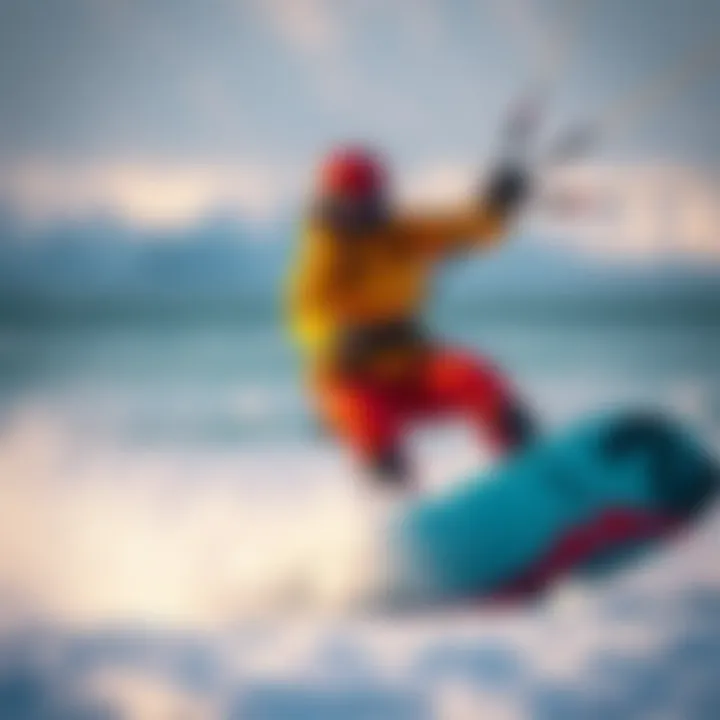
The anatomy of a neoprene suit is crafted for performance. The curves and contours emulate the body’s shape, promoting an ergonomic fit. Features like pre-bent knees and articulated shoulders allow for natural movement.
- Pre-Bent Knees: This design not only eases the act of bending but also encourages an agile stance that can react quickly to the demands of kiteboarding.
- Articulated Shoulders: Some suits employ tapered shoulder designs to provide ease when reaching for your harness, reducing friction while ensuring you can steer and control your kite seamlessly.
The combination of these elements results in a suit that feels more like a second skin than an added layer, allowing you to focus on the ride instead of the gear.
Seam Construction and Its Impact
Seam construction plays a vital role in the effectiveness of neoprene suits. The way these seams are stitched can affect durability, comfort, and waterproof capabilities.
Flatlock Seams
Flatlock seams are a popular choice for many kiteboarders because they create a smooth finish that lies flat against the skin. Key characteristic: The flat nature of the seams not only minimizes chafing but also offers a certain flexibility.
While this style isn't the most water-resistant option, it excels in breathability, making it a suitable pick for warmer conditions. They are often found in lowers suit thicknesses. Their main advantage is comfort, but the downside is that they can allow some water ingress, especially compared to taped options.
Taped Seams
Taped seams, on the other hand, take durability up a notch. Key characteristic: These seams are reinforced with an additional tape on the inside, making them significantly more waterproof than flatlock seams. This makes them ideal for colder climates where water infiltration can sap your body heat.
Taped seams provide a snug feel, crucial for maintaining warmth, and their unique feature lies in their reliability during extreme conditions. However, the downside might be their cost and potentially less stretch compared to flatlock seams.
Blind Stitching
Blind stitching offers a middle ground, combining the benefits of both types. Key characteristic: In this method, two pieces of neoprene are stitched together without fully penetrating the material, which helps keep water out while maintaining flexibility.
This technique can provide the best of both worlds, offering waterproofness and comfort. The distinct feature of blind stitching is the absence of continuous holes, which lessens the risk of water seeping in. However, it requires precision in craftsmanship, making it generally available in high-quality suits and often comes at a higher price point.
In choosing a neoprene suit, understanding the nuances of fit, anatomical design, and seam construction can be the difference between a subpar experience and one that is exhilarating.
Performance Benefits in Cold Weather Conditions
When kiteboarding in frigid temperatures, the performance of the rider hinges not just on skill but significantly on the gear, particularly the neoprene suit. The suit is more than a barrier between the rider and the elements; it directly influences how one maneuvers, stays warm, and ultimately enjoys the ride. In this section, we will break down the specific advantages that a neoprene suit offers in chilly conditions, focusing on mobility, flexibility, and combatting muscle fatigue, all while ensuring that riders maintain optimal performance on the water.
Enhancing Mobility and Flexibility
Being agile on a board while simultaneously battling cold winds is no small feat. A well-designed neoprene suit enhances movement, allowing kiteboarders to twist and turn with ease. Neoprene is inherently elastic. This means that when the suit fits snugly, it adapts to the wearer's movements instead of restricting them. Riders can expect a suit to hug their form, offering the kind of flexibility akin to a second skin.
Factors contributing to this smooth mobility include:
- Material Stretch: Different types of neoprene used in suits, such as ultra-stretch or super flex varieties, increase range of motion.
- Cut and Design: Anatomical paneling in modern suits ensures that tailors sew the seams where they’re least likely to impede movement, optimizing freedom during high-energy activities like jumping or executing tricks.
- Weight and Fit: A lighter suit minimizes drag, enhancing overall speed and agility on the water.
"Staying limber in a cold-weather suit is just as crucial as having the right kite and board. If you can’t move smoothly, every gust of wind will become a hindrance instead of a helper."
Reducing Muscle Fatigue
Kiteboarding demands not just physical skill but also endurance, especially in harsh conditions where cold can potentially sap energy levels. A neoprene suit plays a pivotal role in reducing muscle fatigue. This becomes especially evident during prolonged sessions on the water, where temperature and wind chill threaten stamina.
How does a neoprene suit mitigate fatigue?
- Thermal Retention: The heat generated by the body is trapped by the suit, which helps stave off the chill that can lead to muscle tightening and fatigue.
- Supportive Compression: Many neoprene suits offer mild compression which supports muscles and joints during intense activity. This can lead to less soreness and quicker recovery.
- Hydrostatic Pressure: As water pressure increases with depth or speed, the suit aids in providing balanced pressure across the body, enhancing circulation and reducing the heaviness often associated with cold-water endeavors.
Combining these elements allows riders to concentrate more on their maneuvers rather than battling the adverse conditions, thus transforming their kiteboarding experience into a more enjoyable and productive one.
Selecting the Right Neoprene Suit
Choosing the right neoprene suit is no small feat; it often feels like finding a needle in a haystack when considering all the options available. A suit that fits well is paramount for kiteboarding in cold weather, as it not only keeps you warm but also allows for the necessary flexibility to maintain your performance on the water. The nuances of sizing, thickness, and variety can make a big difference in your overall experience. Each aspect plays a critical role in ensuring that the suit you choose meets both comfort and functionality criteria, important for any adventure enthusiast.
Size and Fit Considerations
Finding a neoprene suit that hugs your body just right is essential. Too loose, and you risk losing warmth as water can enter and flow through, reducing the overall insulating effect. On the other hand, a suit that’s too tight can restrict movement and cause discomfort, possibly even resulting in soreness after long sessions on the water. Here are a few pointers to consider while sizing up an option:
- Body Shape: Everyone's body is unique. Some suits cater to specific body shapes, so exploring options designed for your physique can make a marked difference.
- Layering Considerations: If you prefer to wear additional thermal layers beneath your suit, ensure to account for that in your size selection.
- Try It Out: If possible, wearing the suit before you commit to a purchase can save a lot of hassle. Move around, bend your knees, and stretch your arms; you want to make sure you can move fluidly.
Thickness and Warmth Ratings
The thickness of a neoprene suit—measured in millimeters—significantly influences not only how warm it keeps you but also how much mobility you have while kiteboarding. Here's a closer look:
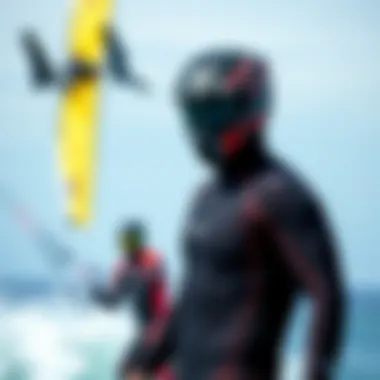
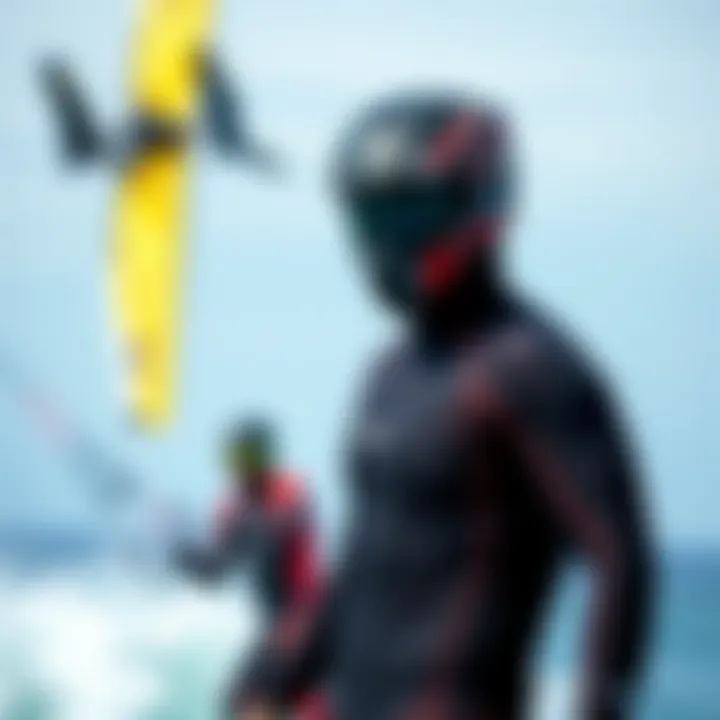
/2mm Suits
These suits are a favored choice among kiteboarders when the temperatures are on the milder side. 3/2mm suits feature 3mm neoprene in the torso for warmth, while limbs are crafted from 2mm neoprene for added flexibility. The key characteristic of a 3/2mm suit is its balanced ratio of warmth and agility, making it a popular option for early spring kiteboarding.
- Benefits: They allow for greater movement, which is incredibly advantageous when executing tricks and maneuvers.
- Disadvantages: As temperatures continue to drop, you’ll find that 3/2mm suits may not provide enough warmth, leaving you chilly after prolonged exposure to cold water.
/3mm Suits
As the weather turns colder, a 4/3mm suit becomes the go-to option for those who prioritize warmth without sacrificing too much freedom of movement. These suits pack a thicker layer of neoprene on the body and a slightly thinner layer in the limbs. A key feature of 4/3mm suits is the extended warmth they provide, essential for longer kiteboarding sessions in chilly conditions.
- Benefits: They cater well to cold conditions, giving excellent insulation, which lowers the risk of hypothermia and allows for more extended sessions on the water.
- Disadvantages: The added thickness can sometimes restrict movement slightly compared to thinner options, though many suits are designed to minimize this issue.
/4mm Suits
The 5/4mm suit is designed for the true cold weather warrior. It is the thickest option available, providing maximum insulation and keeping you toasty warm even in frigid waters. Its primary strength lies in heat retention; the thicker neoprene traps and retains warmth effectively, making it a reliable choice for those venturing into icy waters or colder climates.
- Benefits: Excellent for those who kiteboard in winter or in regions with persistently low temperatures. This suit is your best friend if you're planning a day where the chill factor might be a concern.
- Disadvantages: The trade-off is a significant loss in flexibility compared to thinner suits, which might feel cumbersome when performing intricate maneuvers.
Ultimately, understanding these specific features and how they align with the cold weather kiteboarding experience is vital when selecting a neoprene suit. A well-chosen suit not only enhances your comfort but also ensures you can perform at your best, regardless of the weather conditions.
Care and Maintenance of Neoprene Suits
Caring for your neoprene suit is not just a chore; it’s a necessity that extends the life and performance of the suit, especially if you're a kiteboarding enthusiast facing the perils of chilly waters. The suit is more than just a protective layer—it's your shield against the harsh elements, but it can only serve you well if maintained properly. In this section, we delve into essential practices for washing and storing your neoprene suit, focusing on how these practices can enhance its longevity and maintain its critical insulating properties.
Washing Techniques
Effective washing techniques are pivotal to preserving the neoprene’s integrity. First off, always rinse your suit with fresh water immediately after every session. Salt and chlorinated water can wreak havoc on the material over time, breaking down its structural components and leading to premature wear and tear.
For a deeper clean, follow these steps:
- Fill a bathtub or large basin with cool water: Hot water can damage the neoprene, so stick with cooler temperatures.
- Add a neoprene-specific cleaner: Opt for a product designed for wetsuits, such as McNett Wetsuit Shampoo. Regular detergents may contain harsh chemicals that break down the fabric.
- Gently agitate the water: Avoid scrubbing or twisting the suit, as that can stress the seams.
- Soak for about 10-15 minutes: This allows dirt and bacteria to loosen from the suit.
- Rinse thoroughly: Make sure to remove all soap residue, as left-over chemicals can irritate your skin during the next wear.
- Air dry: Never wring out your suit or put it in the dryer; hang it up away from sunlight to prevent damaging the material.
"A little care goes a long way in prolonging the life of your gear. Your suit deserves the best treatment!"
Storing Your Suit Properly
When it comes to storage, how you keep your neoprene suit can be just as vital as how you clean it. If you toss it into a cupboard crumpled and damp, don't be surprised if it's full of odors or even mold next time you pull it out! Here are some best practices for storage:
- Keep it flat or hang it up: If possible, invest in a wide hanger or a suit rack. Avoid thin hangers as they can cause stretching in the shoulders. If hanging isn't an option, lay the suit flat in a cool, dry area away from direct sunlight.
- Avoid folding: If you have to fold it, do it minimally at the body and not at the limbs. This helps reduce crease lines that could weaken the fabric over time.
- Store in a cool, dark place: Extreme heat or sunlight can break down the neoprene. A closet or a gear bag will do just fine.
- Keep it dry: Ensure that the suit is clean and completely dry before putting it away. Storing it damp can lead to mildew and nasty odors. This is especially important in colder months when you might not use it as often.
Maintaining your neoprene suit through proper washing and storage not only preserves its functionality but also enhances your overall kiteboarding experience. When your gear is in top condition, it allows you to focus on what you love—riding the waves without a hitch.
Innovations in Neoprene Technology
The world of neoprene technology has been advancing rapidly, and these innovations are crucial for kiteboarders braving cold weather conditions. With each new development, the potential for enhanced performance, comfort, and protection grows. In this section, we’ll delve into two significant areas of progress: eco-friendly alternatives and advanced thermal lining materials. Both have the potential to transform how kiteboarders approach their sport in less-than-ideal weather while being conscious of environmental impacts.
Eco-Friendly Alternatives
As environmental concerns loom large over every industry, the kiteboarding community is no exception. Traditionally, neoprene has been criticized for its environmental footprint, especially due to the chemical processes involved in its production. However, recent strides have made headway in creating eco-friendlier alternatives.
Several brands are now experimenting with neoprene derived from plant-based sources, such as Yulex. This biobased rubber isn’t just a marketing gimmick; it provides the same insulative properties as conventional neoprene but with less environmental damage. Moreover, brands like Patagonia are utilizing recycled materials, reducing reliance on new resource extraction. These alternatives not only maintain thermal insulation but are also lighter and just as durable as their petroleum-based counterparts.
"Choosing eco-friendly alternatives isn’t just a trend. It’s a commitment to preserving the environment while enjoying our adventures." - Environmental Advocate
When selecting a suit, it’s refreshing to see companies like O'Neill and ION leading initiatives that embrace sustainability. By making informed choices, consumers contribute to gradual shifts in the industry, encouraging further eco-conscious innovation.
Advanced Thermal Lining Materials
Another exciting area of neoprene technology is the advent of advanced thermal lining materials. These innovations focus on optimizing heat retention while minimizing bulk, allowing for better mobility without sacrificing warmth.
One of the standout materials is Thermal Smoothie, a high-performance lining that retains body heat while being quick-drying. This fabric is often combined with conventional neoprene, creating a barrier that can keep the cold at bay even when wet. Kiteboarders in frigid waters can appreciate how effective this technology is during prolonged sessions.
Moreover, thermal fleece linings are becoming increasingly popular. This soft material adds an extra layer of insulation and comfort. Not only does it provide warmth, but it also feels pleasant against the skin, preventing discomfort from long wear. The blend of these high-tech materials not only enhances the durability of suits but makes them aesthetically appealing as well.
In essence, innovations in neoprene technology are not just about keeping warm; they represent a significant evolution towards a more sustainable, efficient, and enjoyable kiteboarding experience. As technology continues to develop, enthusiasts can expect even greater improvements in both performance and environmental responsibility in their gear.
The Role of Accessories

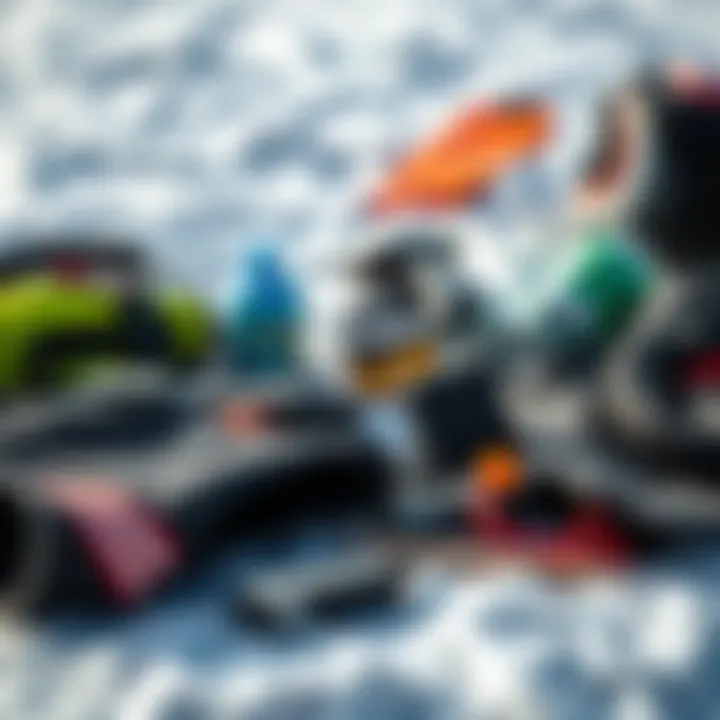
When kiteboarding in colder weather, having the right accessories can make all the difference. While the neoprene suit itself is crucial for thermal insulation, the supporting gear can enhance comfort, protect against the elements, and improve overall performance. Accessories such as hoods, gloves, and boots provide those extra layers of protection and warmth, ensuring that you are not just surviving the cold but thriving in it.
High-quality accessories are designed to work in tandem with neoprene suits, offering specific functionalities that boost your kiteboarding experience. They can keep extremities warm, maintain dexterity, and prevent losses in body heat during those chilling gusts. So, let’s dive into the importance and functionality of two vital accessory categories: hoods and gloves, and boots.
Hoods and Gloves
Hoods and gloves are often overlooked, but they play an essential role in maintaining warmth. The head and hands are particularly vulnerable to cold, and any discomfort in these areas can distract from the riding experience.
Hoods not only trap warmth but also cover a lot of surface area where heat can escape. When selecting a hood, you want something that fits snugly without being restrictive. Look for hoods made from high-quality neoprene with features such as built-in chin straps and neck gaiters that minimize gaps. A well-fitted hood can significantly reduce the chances of losing heat as you ride.
Gloves share a similar priority. Cold fingers can quickly sap your strength and precision while controlling the bar. When plastic beads of water begin to form on your palms, a pair of performance gloves can mean the difference between nailing a jump or a wipeout. Opt for gloves that provide dexterity without sacrificing warmth; thinner, high-stretch options often excel in allowing a full range of movement.
"Cold hands can lead to poor grip, affecting control and balance while riding. A good pair of gloves keeps you in the game and ready for anything."
Boots: Choosing the Right Pair
Selecting the right pair of boots is another key accessory consideration when kiteboarding in cold weather. While some riders may prefer to kite barefoot, boots can add a whole new level of stability and grip, particularly on choppy waters. They provide insulation and protection against the cold water and any potential impacts.
When looking for the perfect pair of boots, consider the thickness of the neoprene, which can range from 3mm to 7mm. Thicker boots offer more warmth, while thinner ones allow for better flexibility. A snug fit is essential; boots should feel like a second skin while still allowing for blood circulation.
Several features to consider include:
- Sole Thickness: A thicker sole provides added cushioning but can affect sensitivity. Balance is key.
- Split Toe vs. Full Toe: Split-toe designs allow better board feel, while full-toe options may provide more warmth.
- Closure Types: Look for boots with a secure closure system, like velcro straps or zippers. Easy on-and-off functionality is a great bonus.
To sum up, accessories like hoods, gloves, and boots should not be an afterthought in your kiteboarding gear. They play pivotal roles in ensuring that you stay warm, nimble, and in control while navigating windswept waves. As you gear up for your next adventure, remember that these essentials go hand in hand with your neoprene suit to create a well-rounded kit capable of tackling cold weather with ease.
Real-Life Experiences and Testimonials
Understanding the practical aspects of neoprene suits in kiteboarding comes alive through the experiences of skilled riders who have faced the elements head-on. These firsthand accounts dive into the reality of kiteboarding in cold conditions, shedding light on the strengths and weaknesses of neoprene suits as essential gear.
Insights from Experienced Riders
One of the most potent parts of learning about neoprene suits is hearing from those who spend countless hours riding in them. For example, Sarah, a seasoned kiteboarder from the coast of Maine, recalls a frigid winter day when she wore a 5/4mm suit while conquering the waves. "The wind chill made it feel like a different universe out there," she says. "But I was pleasantly surprised how my suit kept me warm and agile, allowing me to focus on my tricks instead of shivering."
- Sarah's experience highlights several key points:
- Thermal Efficiency: The thickness of her neoprene suit was pivotal. It offered insulation, ensuring she remained warm even in biting temperatures.
- Mobility: Despite the suit’s thickness, Sarah felt a remarkable range of motion, enhancing her overall performance.
Similarly, John, who resides in the Pacific Northwest, speaks highly of his ultra-stretch neoprene suit. "It's like a second skin. Having freedom to move is vital, especially when dodging waves and grabbing air during tricks. I didn’t even feel the cold until I took a break!"
Common Challenges Faced
While the endorsements of experienced kiteboarders are invaluable, they often also touch upon challenges that come with the territory.
- Sizing Issues: Accurate fit matters immensely. Both Sarah and John emphasize how a poorly fitting suit can lead to water seepage, which cools one down almost instantly. An ill-fitting suit is more than a discomfort; it affects performance and safety in cold weather.
- Maintenance Concerns: John mentions the upkeep of his suit. "After a long session, there’s nothing worse than putting on a damp suit the next day because I didn't rinse it properly. Care is integral to the longevity and performance of the suit."
*"Every session teaches you something new. Embracing the journey helps elevate performance—both the joys and the struggles."
Moreover, experiences shared in online communities, such as forums on reddit.com or specialized groups on facebook.com, offer diverse insights. Riders frequently discuss the impacts of water temperature, wind conditions, and personal preferences, leading to a broader understanding of how to choose the right suit and what to expect.
End: The Neoprene Suit as a Critical Asset
In the world of cold weather kiteboarding, a neoprene suit is not just an accessory; it’s an essential piece of gear that can dramatically influence the quality of your experience on the water. As kiteboarders face frigid temperatures, wind chill, and the inevitable splash from the waves, the right suit becomes a barrier against the elements. It’s crucial to recognize how these suits blend innovation and practicality, making them a cornerstone for safety and performance.
Neoprene suits are engineered to offer support in several key areas. From thermal insulation and enhanced mobility to comfort and durability, every detail is hungrily crafted to ensure the rider can focus on the thrill without the distraction of discomfort. The ability to maintain heat, even in a chilly ocean breeze, does not merely enhance enjoyment; it can prevent hypothermia and other cold-related risks.
"A good neoprene suit feels like a second skin; it allows for free movement while keeping you toasty. That’s the sweet spot every rider seeks."
Final Thoughts on Suit Selection
Choosing the right neoprene suit is a lot like picking a partner for a dance: you want the right fit, flexibility, and comfort to make the most of every moment. While looking at sizes and thickness, one must also consider factors like water temperature and personal riding style. Make sure to:
- Consider the fit and seal: A snug fit minimizes water entry, while too tight can restrict movement.
- Evaluate material types: From standard to ultra-stretch neoprene, understand which kind fits better for your adventure.
- Check for features: Look for reinforced seams and zippers that withstand wear and tear, enhancing your suit’s longevity.
In the end, the perfect neoprene suit isn't just about warmth; it's a holistic package designed for superior performance. Riders should aim to balance warmth without sacrificing mobility.
Preparing for Your Next Cold Weather Adventure
Before you hit the waves, it's wise to prepare – both mentally and physically. Beyond your neoprene suit, consider what else you need for an effective outing. Here are some pointers to get you ready:
- Gear Check: Don’t forget to inspect your kite, board, and harness. Everything must be in optimal condition to maximize your performance.
- Layer Up Wisely: Depending on how frigid it is, water boots and gloves can also make a world of difference, so think about your extremities.
- Acclimatization: If you can, take time to get your body used to the cold before plugging into the full kiteboarding experience. Even a bit of pre-exposure can help your body adjust.
- Safety First: Always inform someone about your plan, especially in treacherous conditions. Knowing your limits is part of staying safe and enjoying the thrill.
As much joy as kiteboarding brings, preparation and the right gear allow you to savor the experience fully, no matter how harsh the weather. With each ride, you deepen your bond with the unpredictable gift that nature offers.



